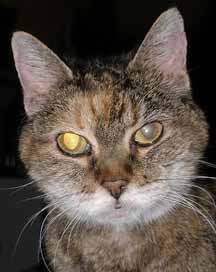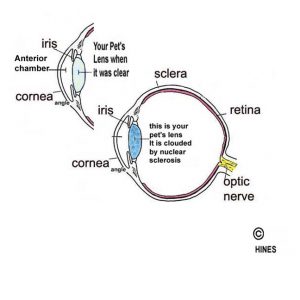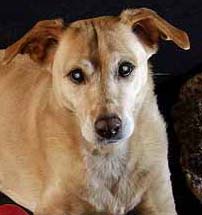Cloudy Eyes In Your Dog And Cat That Aren’t Cataracts And Some That Are
Ron Hines DVM PhD
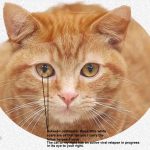 What Causes Those White Spots On My Cat’s Eyes?
What Causes Those White Spots On My Cat’s Eyes?
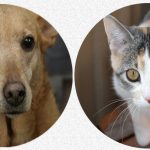 Corneal Ulcers On Your Dog Or Cat’s Eye
Corneal Ulcers On Your Dog Or Cat’s Eye
 Glaucoma In My Dog Or Cat’s eyes
Glaucoma In My Dog Or Cat’s eyes
Your dog or cat’s lenses should be crystal clear. During its early adult life they probably were. But as your dog or cat gets older, you will notice a certain milkiness deep within its eyes. Some of these cloudy lens situations are true cataracts. But the majority are not. They are the natural effect of aging on the way light reflects back at you from the pet’s lenses. It is due to a change in the consistency of the lenses, and it is more appropriately called lenticular sclerosis. The pet’s lenses have become denser and bounce (refract) more light back at you.
This article is about cloudy eyes and cataracts in your older dog and cat.
More About Nuclear (lenticular) Sclerosis – The “Cataracts” of Normal Aging
This is the most common form of “cataract”. They are the ones you see in the photographs of the dog and cat at the top of this page. The lenses in your pet’s eyes are composed of fine, transparent, protein fibers (crystalline). About two thirds of the lens’s weight is water. As your pet gets older, these fibers arrange themselves more densely (closer together). In that arrangement, more light bounces back at you when you look into your pet’s eyes. The eye structures it passes through give that light a bluish gray tint. It becomes evident to most pet owners when a dog reaches about six years of age and in cats a bit later. But changes had begun several years before that.
The lens changes of old age almost always occur in both eyes simultaneously. Once they are pronounced, the pet’s pupils are often dilated (enlarged) to allow more light to reach the retinas. They do this instinctively to improve their vision.
All our pets develop these milky lenses. It doesn’t mean they are getting forgetful or that their general health is failing – just that the matrix of the pet’s lenses no longer reflect light as they once did. Because considerable light still passes through these lenses, your pet can see considerably better than you might imagine
Your veterinarian or a veterinary ophthalmologist can confirm that your pet’s cloudy eyes are due to lenticular sclerosis and not true cataracts. You can try it at home as well. The technique is called retro-illumination. In a darkened room, with a penlight flashlight near your nose, shine the light into each of your pet’s eyes. When a normal eye or an eye with lenticular sclerosis receives that light, it will bounce back toward you with a greenish to yellowish glow from the reflective surfaces of the pet’s retina (the tapetum). You should also see those distinctive colors if you take a photo of your pet’s eyes in a dark room using a flash. True cataracts and other eye disease (such as some cases of glaucoma, retinal or corneal damage) that alter the way light passes through your pet’s eyes do not allow light to return.
Having the cloudy lenses of old age does not mean that there cannot be other things wrong in your pet’s eyes. If the pet is bumping into objects, hesitant in walking, hesitant in new settings or its close up vision is not what it used to be, other things could be going on in its eyes as well. In cats, high blood pressure (often associated with kidney issues) is responsible for a considerable number of cats with vision loss.
Causes Of True Cataracts:
When signs develop in pets at an earlier age or in just one eye, they are due to other causes, not simple lenticular sclerosis of aging. When it is the lenses that are affected, true cataracts are a more likely cause. As true cataracts mature, they often develop crystalline cracks that look like the cracks in a marble that has been dropped or give a crushed ice appearance. Birth defects account for many of these cases when cats or dogs are born with them or develop them quite young. Diabetes is a leading cause when they develop later. In cats, a leading cause of generalized eye inflammation that occasionally affects the lens as well is FIP.
Congenital (Birth defect) Cataracts
Certain dogs and cats are destined from birth to develop cataracts. We do not know why. Certain lines of Afghans, fox terriers, bichons, cocker spaniels, Boston terriers, miniature schnauzers, standard poodles, malamutes and westies have all occasionally suffered from this condition. Congenital cataracts are uncommon in cats. When they occur it is generally in inbred lines of Persians, Birmans, Bengals, British Shorthair and Himalayans.
Cataracts Due To A Deficient Infant Diet/Malnutrition
Star-crossed puppies and kittens that did not receive an adequate diet are also prone to develop cataracts. These are often strays and foundlings whose mother subsisted on whatever scraps she could find. Deficiencies in taurine, arginine, histidine methionine and phenylalanine have all been associated with cataract formation in young animals. Read about that here.
Cataracts Due To Eye Injury
When a cataract forms in a single eye, it can be due to a prior eye injury. Injuries that damaged the circulatory system of fluids within the eye or the strands that hold the lenses in place can all lead to cataracts. When trauma, such as a car accident, wrenches the lens from the fine Zinn fibers that hold it in place, cataracts in that lens often develop.
Cataracts Due To Eye Inflammation
Diseases that result in inflammation of the anterior chamber (uveitis) of your pet’s eye can result in cataracts. As I mentioned, In cats, FIP is a common cause. But Feline leukemia or Feline AIDS can also predispose cats to cataract in round about ways. Eye inflammation in pets can also be associated with exposure to raccoons. They carry a parasite that you can read about here.
Diabetes
Dogs that develop diabetes sometimes develop cataracts. In these dogs, uncontrolled high blood sugar eventually causes the lenses of the eye to lose clarity. It is a less common cause of cataracts in cats.
What Can I Do For My Pet?
The first thing to do is to set an appointment with your veterinarian to have your pet’s eyes examined. Your veterinarian will know if the cataracts you see in your pet are typical of those seen in normal aging. If your veterinarian has any doubt, the vet may run some additional tests to eliminate the possibility of an underlying disease and may suggest a veterinary ophthalmologist consult as well. If the data comes back suspicious, other diagnostic tests and treatment might be needed.
It is possible to surgically remove cataracts that affect your pet’s vision. Whether or not this should be done is debatable. Dogs and cats with little or no vision appear to lead very happy contented lives. Both dogs and cats “see” the world through their sense of smell as much, or more so than their sense of vision. The rich delights of tasty food, your companionship and the scents and sounds of their familiar home remain intact in these pets and I believe that they remain quite content.
A second treatment problem is that acute (accurate) vision when your pet’s lenses have been removed, requires lens implants. Without them, only some blurry vision is possible. There are many advanced veterinary centers that will perform lens implants in dogs and cats. The surgery can be successful. Cornell Veterinary School performs many of them. However, I do not recommend it for most dogs or cats. If you have a younger pet that has become blind or was born blind because of cataracts, perhaps you might consider it. The same might apply for owners of working dogs that must earn their living, legitimate service dogs and the like.
If you decide not go that rout, there are two factors in your pet’s favor. The first is that cataracts tend to look much worse than they really are. If a veterinarian uses his/her ophthalmoscope and can see the retina well – then the dog or cat can see out equally well. If your pet’s pupils constrict when a bright light is focused on them, your pet also retains some vision.
Many health professionals suggest giving dogs and cats anti-oxidant supplement in an attempt to slow the development and progression of cataracts. Vitamin E (d-alpha tocopherol acetate) and vitamin C (ascorbic acid) are easily purchased and do not taste that bad to your pet. They can be dripped and crushed on its regular food. Don’t get carried away in the amounts. Anti-oxidants are touted as slowing the progression of age-related changes of all kinds in animals and people. But in humans, the only vitamin combination thought to perhaps slow age-related changes in the lens are those that replicate the AREDS2 formula.
Another thing that might slow the formation of cataracts is limiting your pet’s exposure to bright sunlight. Time your walks to the early morning and late afternoon or evening and be sure your yard has shaded areas if your pet spends much time there. Read about that here.
Feeding a balanced diet and taking care of other pet health issues might also slow the development of all the problems associated with aging.
How Much Does Vision Loss Bother My Pet?
You already know my feelings on that. Although pets that are blind or nearly so may bump into objects, almost all soon learn to use their remaining senses to get around that problem quite well. Those pets only appear disoriented and hesitant in unfamiliar settings. As I mentioned before, that’s because your pet’s sense of smell and proprioception is so much better than yours or mine. Dogs and cats lives in a world quite different from the world that we experience – one of comforting sounds, aromas, scents and interactions with its owners. So, I believe that it’s world and sense of well-being does not change that much because it has lost its vision – not nearly as much as our world would change if we lost ours. When an old pet’s ability to do well declines with age, consider canine cognitive dysfunction or arthritis as more likely causes than the presence of cataracts or nuclear sclerosis.
My chief concern in cats and dogs with vision problems is when pain, increased interocular pressure or eye inflammation accompany it. Cataracts are not in themselves painful. If your pet is squinting, lacrimating (producing tears) or if the shape of its eye has changed, there are probably other more serious problems going on in its eye that need tending to. Those pets need your veterinarian’s immediate attention.
You are on the Vetspace animal health website
Visiting the products that you see displayed on this website help pay the cost of keeping these articles on the Internet.

